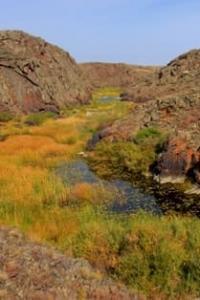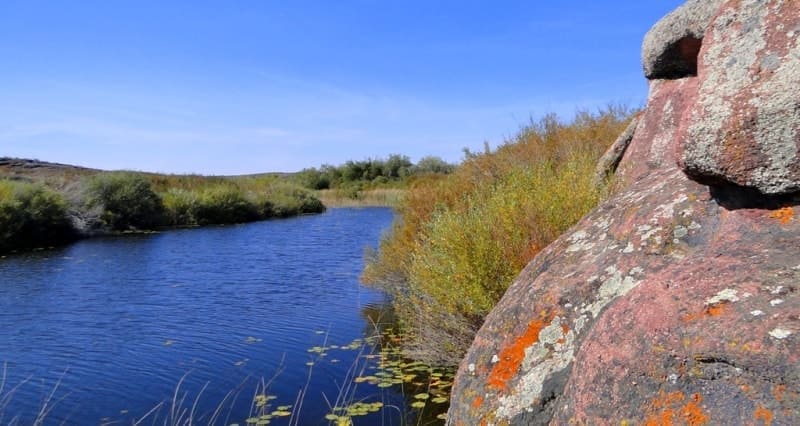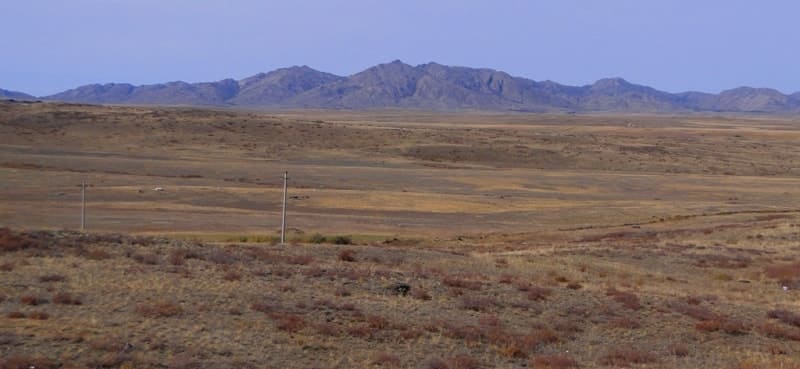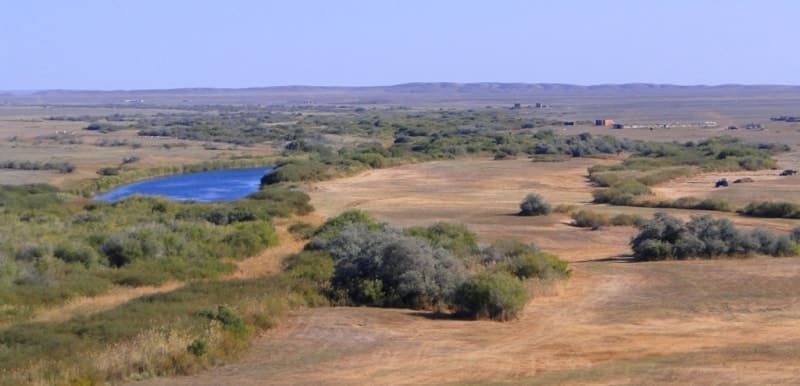Вы здесь
Mountains of Ulytau.

Tours over mountains of Central Kazakhstan.
"August must be sipped slowly, like pear liqueur.
Pour into a small glass, sip drop by drop, and look at the sun through the glass.
August nights should be diluted with the lights of candles, milk poured into a brownie bowl, the purring of a cat and the chirping of grasshoppers. August days should be laid between the pages of books, like
ookmarks, in order to shake out their heat in dank November by taking this book off the shelf.
And I conjure you, well, don’t shout at all corners, “oh, here is August, here is autumn.” Well, where are you in a hurry? Stop the clock. Drink drop by drop."
"Goodbye summer". Ray Bradbury.
Kazakhstan tours and Central Asia journeys.
Ulytau mountain range (Kazakh Ulytau literally "Great Mountains") is located in the central part of the Kazakh uplands on the territory of the Ulytau district of the region of the same name. The average absolute height of the mountains is 400 - 600 meters above sea level, some areas are up to 800 - 1131 meters above sea level.
The massif consists of small low mountains and ridges. In the northeastern part are the Saryoba mountains with the highest elevation of 738 meters above sea level. In the north, there is the Zhanalayak ridge with the highest elevation, Atabulak mountain, 677 meters above sea level.
To the east are the Akshoky mountains with a dominant mountain 501 meters above sea level. Here, the Edyge Mountains with the highest mountain of the same name, 1063 meters above sea level, belong to the main massif.
In the south-west, the massif includes mountains: Zhakyntas with the dominant mountain Karagandyshoky 637 meters above sea level, Barak with the dominant mountain Akshoky 530 meters above sea level, Kakyntas with the dominant mountain Karaadyr 674 meters above sea level.
The most southwestern Kishatau mountains with a dominant mountain 793 meters above sea level. In the east, the massif includes the Airtau mountains with a dominant mountain 854 meters above sea level and the Karatal and Esimbekkotyr hills.
In the southeast, the Ulytau mountain range includes mountains: Zhamankotyr with a dominant mountain 602 meters above sea level, Araltobe with a dominant mountain 641 meters above sea level. In the very southeast lie the Akzhal Mountains, dominated by a mountain 595 meters above sea level.
In the western part of the Ulytau mountains, there is the highest peak of the Aulie massif, 1131 meters above sea level. The second highest is Mount Edyge, 1063 meters above sea level, and the third highest is the mountain located in the northern part of the mountains - Koltau, 925 meters above sea level.
The length of the massif from southwest to northeast is more than 105 kilometers, the maximum width in the central part reaches 27 kilometers. The Ulytau massif is located in the Caledonian folding zone, surrounded by semi-deserts in the latitudinal zone.
The mountains are strongly dissected and rocky to the base. The main part of the mountains is composed of collapsing granites and is so exposed by arid denudation that “in many places it appears as a mountainous rocky desert without any developed soil cover” (Gvozdetsky, Nikolaev, 1971, p. 185 ).
Only in the crevices of the rocks sparse sods of steppe grasses, wormwood, small shrubs huddle, and thickets of creeping Cossack juniper and deciduous shrubs settle on large talus consisting of large boulders.
On the slopes and stony peaks, representatives of light forests (birch, aspen, juniper) grow on light chestnut soils, shrubs near the river coast: raspberry, currant, willow, as well as feather grass, tipchak, wormwood.
The unproductive desert steppe pastures, which are widespread in places, are used for grazing small cattle and camels. In the region of the Ulytau mountains, deposits of iron and ferromanganese ores, polymetals, brown coals are known.
Ulytau is rich in minerals: iron, manganese ores, polymetals, brown coal, rare metals, etc. Soviet geologist, academician K. I. Satpaev contributed to the exploration and development of Ulytau mineral deposits. The massif is composed of highly metamorphosed and dislocated Archean and Proterozoic rocks (crystals, schists, quartzites, quartz porphyries, porphyrites and their tuffs).
There are effusive-sedimentary strata of the Lower Paleozoic. The climate of the region is continental. The average temperature in January is 24 - 25°С, in July 22°С. Atmospheric precipitation 200 - 250 mm per year.
The rivers of the Turgai basin (Karaturgai, Saryturgai, Ulken Zhylapshyk) and the Sarysu river basin (Karakengir, Zhezdy, etc.) originate in Ulytau. The food is snow, the main flow of water falls on the spring. Underground waters are poorly mineralized, suitable for drinking and household needs (reserves are estimated at 30 billion cubic meters).
Mountain landscapes are mainly desert-steppe. At the foot of Ulytau there are forb and cereal meadows, meadow solonchaks. The animal world is represented by wolves, foxes, squirrels, badgers, argali, roe deer, black grouse, partridge are found among ungulates.
On the slopes of Ulytau (Baskamyr and others) archeological monuments of the ancient urban culture of the Kazakh people were discovered. In March 2022, the President of Kazakhstan, Kassym-Jomart Tokayev, announced that the Ulytau region would be formed on the territory of the Karaganda region within the former Dzhezkzgan region, which was created in 1973 and lasted until 1997: “The creation of an independent region in this region is an important decision not only from an economic point of view, but also spiritually: Ulytau, which is located in the center of our endless Kazakh steppe, occupies a special place in the history of our country.
Great meetings were held here, where the fate of the country was decided. On June 8, 2022, the Ulytau region was formed on a part of the former Zhezkazgan region.
Geographical coordinates of Ulytau mountains: N48°38'13.57" E66°55'31.67"




Authority:
Gvozdetsky N.A., Golubchikov Yu.N. "Mountains", series "Nature of the World". Moscow, Thought, 1987.
A. S. Besenova, T. G. Smagulova.
Alexander Petrov.
Photos by
Alexander Petrov.







